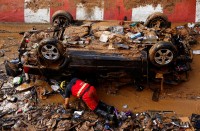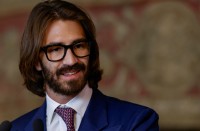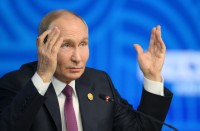The remains of King Richard III left the University of Leicester on Sunday (March 22) to make their final journey to Leicester Cathedral.
Richard, the medieval English monarch whose remains were found under a car park three years ago, will be reburied on Thursday (March 26) nearly 530 years after he was slain in battle and dumped in a humble grave. He was the last English king to die in battle when he was killed at the Battle of Bosworth Field in central England in 1485.
Before reaching Leicester Cathedral at 5.30pm (1730gmt) the cortege with his coffin will tour villages in Leicestershire and the battlefield site at Bosworth. Services will be held at various key points enroute, including Bosworth Battlefield.
The first ceremony of the day was held at Leicester University before Richard’s remains were carried by undertakers to a waiting hearse.
“So it is my pleasure to welcome you all here today to this ceremony to mark the departure of the mortal remains of King Richard III from the University of Leicesteras they make their journey to their final resting place in the Cathedral church of St Martin Leicester,” Chancellor of the University of Leicester Bruce Grocott said.
The final service of the day will take place at Leicester Cathedral with a sermon given by the Catholic Archbishop of Westminster, Cardinal Vincent Nichols.
Richard’s body will be re-interred at Leicester Cathedral next Thursday in an oak coffin designed by a descendant whose DNA helped identify the remains. He will also win the regal recognition supporters say his conqueror Henry Tudor, laterHenry VII, denied him.
Shakespeare depicted Richard as a tyrannical, hunchbacked, bloodthirsty monster who murdered his way to the throne on the death of his brother Edward IV and famously went down fighting to keep his crown crying out “A horse! A horse! My kingdom for a horse!”.
Among his alleged victims were former King Henry VI, another of his brothers, and his own nephews – the “Princes in the Tower”, one of them 12-year-old Edward V, the rightful king.
But the Richard III Society and others have argued he was a much-maligned, benevolent ruler, innocent of the crimes Shakespeare laid at his door.
One of those disbelieved the Shakespeare version was screenwriter Philippa Langley, who spent seven years searching for the monarch whose naked body was taken from the battlefield at Bosworth to the Grey Friars’ friary in Leicesterwhere it was buried.
While grand sepulchres house the remains of most English monarchs inWestminster Abbey and Windsor Castle, Henry VII, paid just 10 pounds for a memorial to Richard.
It was thought the body was even thrown in a nearby river at a later date but Langley’s hunch that the remains were under a municipal car park where someone had painted a letter R on the tarmac proved correct.
DNA tests have since left scientists 99.999 percent sure the skeleton with a curved spine was indeed Richard. Tests showed he had suffered 11 wounds, including nine to the skull and a potentially fatal blow to the pelvis.
The wounds were consistent with accounts that he died, unhorsed, having lost his helmet in battle.
Thursday’s ceremony will be overseen by the Archbishop of Canterbury, the spiritual head of the Anglican Church, with the current royal family represented by the Countess of Wessex, the wife of Queen Elizabeth’s youngest son PrinceEdward, and the queen’s cousin, the Duke of Gloucester.
Reuters








